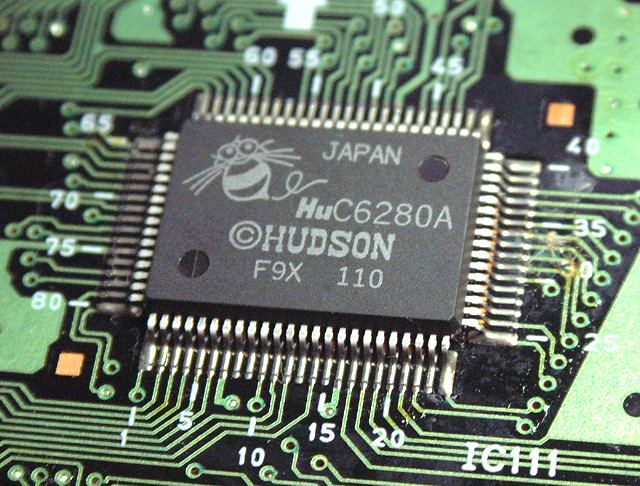 | ||
The HuC6280 8-bit microprocessor is Japanese company Hudson Soft's improved version of the WDC 65C02 CPU, an upgraded CMOS version of the popular NMOS-based MOS Technology 6502 8-bit CPU manufactured for Hudson by Seiko Epson. The most notable product using the HuC6280 is NEC's PC Engine video game console.
Contents
Description
The HuC6280 contains a 65C02 core which has several additional instructions and a few internal peripheral functions such as an interrupt controller, a memory management unit, a timer, an 8-bit parallel I/O port, and a programmable sound generator. The processor operates at two speeds, 1.79 MHz and 7.16 MHz.
Memory mapping
The HuC6280 has a 64 KB logical address space and a 2 MB physical address space. To access this entire memory space, the HuC6280 uses an MMU (Memory Management Unit) that splits the memory space into segments of 8 KB. The logical address space is split as follows:
page 0 -> $0000-$1FFF page 1 -> $2000–$3FFF page 2 -> $4000–$5FFF page 3 -> $6000–$7FFF page 4 -> $8000–$9FFF page 5 -> $A000-$BFFF page 6 -> $C000-$DFFF page 7 -> $E000-$FFFFEach logical 8 KB segment (or page) is associated with an 8-bit register (MPR0-7) that contains the index of the 8 KB segment (or bank) in physical memory to map in this page. Two special instructions are used to access these registers:
TAMi, transfer the content of the accumulator (A) into an MPR register (0-7).
TMAi, transfer an MPR register into the accumulator.
HuC6280's PSG
The PSG provides 6 sound channels, which can be conveniently paired according to the functionality they provide:
0-1 - Waveform playback Frequency modulation (channel 1 muted) 2-3 - Waveform playback only 4-5 - Waveform playback White noise generationWaveform playback is the most common and allows a 32 byte, 5 bit unsigned linear sample to be played back at selected frequencies. Frequency modulation takes this one step further, allowing the playback frequency to be dynamically adjusted according to a specified pattern. White noise is used to simulate percussion instruments and effects, such as explosions, by means of a pseudo-random square wave.
Alternatively, each channel can be individually switched to "Direct D/A" mode in which the programmer can send data directly to the sound mixer, allowing more complex sound patterns to be generated, such as speech. Inevitably, this requires more programming effort and CPU time.
